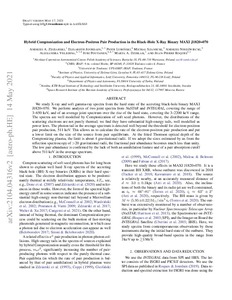Hybrid Comptonization and Electron-Positron Pair Production in the Black-hole X-Ray Binary MAXI J1820+070
Jourdain Elisabeth; Dziełak Marta A.; Veledina Alexandra; Szanecki Michał; Lubiński Piotr; Poutanen Juri; Zdziarski Andrzej A.; Niedźwiecki Andrzej; Roques Jean-Pierre
Hybrid Comptonization and Electron-Positron Pair Production in the Black-hole X-Ray Binary MAXI J1820+070
Jourdain Elisabeth
Dziełak Marta A.
Veledina Alexandra
Szanecki Michał
Lubiński Piotr
Poutanen Juri
Zdziarski Andrzej A.
Niedźwiecki Andrzej
Roques Jean-Pierre
IOP PUBLISHING LTD
Julkaisun pysyvä osoite on:
https://urn.fi/URN:NBN:fi-fe2021100750383
https://urn.fi/URN:NBN:fi-fe2021100750383
Tiivistelmä
We study X-ray and soft gamma-ray spectra from the hard state of the accreting black-hole binary MAXI J1820+070. We perform an analysis of two joint spectra from NuSTAR and INTEGRAL, covering the range of 3-650 keV, and of an average joint spectrum over the rise of the hard state, covering the 3-2200 keV range. The spectra are well modeled by Comptonization of soft seed photons. However, the distributions of the scattering electrons are not purely thermal; we find they have substantial high-energy tails, well modeled as power laws. The photon tail in the average spectrum is detected well beyond the threshold for electron-positron pair production, 511 keV. This allows us to calculate the rate of the electron-positron pair production and put a lower limit on the size of the source from pair equilibrium. At the fitted Thomson optical depth of the Comptonizing plasma, the limit is about 4 gravitational radii. If we adopt the sizes estimated by us from the reflection spectroscopy of >20 gravitational radii, the fractional pair abundance becomes much less than unity. The low pair abundance is confirmed by the lack of both an annihilation feature and of a pair absorption cutoff above 511 keV in the average spectrum.
Kokoelmat
- Rinnakkaistallenteet [27094]
